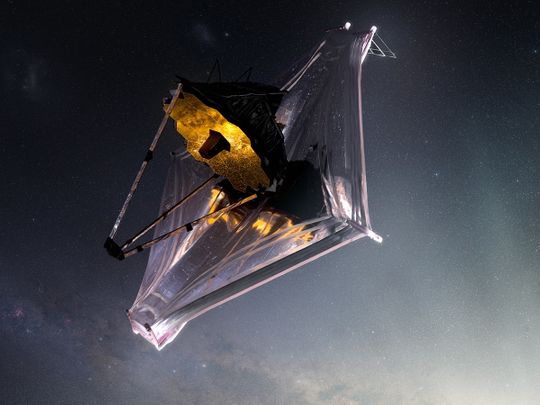
When the James Webb Space Telescope revealed its first images of space in July this year, the world shared a collective gasp.
Click start to play today’s Spell It, which makes you realise how ‘small’ we are, in our tiny corner of the endless universe.
After several delays, the largest optical space telescope was launched into the cosmos on December 25, 2021 by US space agency National Aeronautics and Space Administration (Nasa). The James Webb telescope was inspired by the Hubble Space Telescope – the famous 31-year-old observatory that’s responsible for most of the stunning photos of distant galaxies you can find on the internet.
A joint collaboration between Canada, Europe and the US, James Webb Space Telescope is Hubble’s tech-savvier, smarter younger brother – it takes stargazing to the next level. Firstly, its massive, 21.3-foot primary mirror helps it become the furthest-seeing telescope ever built. Secondly, the telescope views the universe in infrared, a zone that has slightly longer wavelengths than visible light, on the electromagnetic spectrum.
Here's what astronomers hope the James Webb Space Telescope will be able to observe:
1. Galaxy formation
Telescopes are like time machines, allowing viewers to look back in time, since light from galaxies takes several light-years to arrive at Earth. For instance, since the Canis Major Dwarf Galaxy is 25,000 light-years away from Earth, we’re seeing it as it was 25,000 years ago. Scientists hope to look further into space so that they can see further back in time, and piece together how galaxies are formed, by observing them at different stages of development.
2. Signs of life
Does life exist on other planets? If it does, it likely will release distinct chemical signatures, according to a December 2021 report by the Smithsonian Magazine. The Webb telescope can detect infrared wavelengths for chemical fingerprints, such as water and methane, in the atmosphere of exoplanets, allowing scientists to look for life there and even assess the planets’ ability to support human life.
3. Birth of stars

The birthplaces of stars are notorious for being full of dust. While they make for spectacular photographs, like the iconic ‘Pillars of Creation’ in the Eagle nebula, the dust stops astronomers from looking through to the core of the clouds. However, the infrared light emitted from stars can penetrate through the dust, which means constellations are getting a high-resolution upgrade like never before, with the Webb telescope. Infant stars, especially, can be viewed now with unprecedented detail, and scientists can now study why stars form in clusters, and how planets form around stars.
4. Black holes
Mysterious black holes swallow everything – even light. So, how do you study one? Scientists focus on the stars, dust, and even entire galaxies that swirl around the black hole – things that are observable to them. Over the past decades, scientists used X-ray telescopes to try to understand the physics of how black holes work. While X-rays are produced by phenomena that are millions of degrees hot, like stars torn up by a black hole, Webb telescope’s infrared vision will pick up data on cooler gases and stars slightly further away from the black hole. This whole new perspective is like peering past a dusty curtain. Now, astronomers can fully understand the mass and size of black holes, and how and why they consume everything in their path.
What do you think of the enormous potential of the James Webb Space Telescope? Play today’s Spell It and tell us at games@gulfnews.com.



